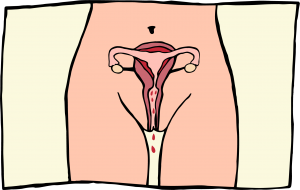menstruation

Most people use the word ‘period’, because they feel that it sounds nicer. Menstruation is a medical word. Mensis is Latin for ‘month’, so menstruation only means something like ‘monthly flow’. But many people feel that it is a bit of a dirty word, so they prefer to use ‘period’. Everybody understands what a girl means when she says: ‘I have my period’. Some say: ‘I have the curse’, which shows they don’t like it very much. Menstruation can be a curse when it hurts or bleeds a lot or when it makes you feel sick or dirty just when you’re going to a party and meet that nice boy.
How menstruation starts
Girls have their first period when they are 12-14 years old. Some are earlier, some are later. The first period is one of the signs of puberty. It is the monthly loss of some blood and lining from the womb. This happens as follows: When a girls reaches puberty, a hormone is produced by a part of her brain. This hormone reaches her ovaries and stimulates one of the follicles (unripe eggs) in it to come out and move into the Fallopian tube connecting with the womb. The egg takes about a week to get to the womb. The womb, in that time, gets ready to receive the egg. The lining of the womb gets thicker. But the egg will only need to use that if it is has been fertilised, because only then does it grow into a baby. It takes a male sperm cell to fertilise the egg. It’s the same with all the animals around us. Mostly there is no male sperm in the tube and so no fertilisation. This means that the womb has thickened its lining for nothing. So after about two weeks the lining breaks off and comes out through the vagina with some blood. This is the menstrual bleeding. It lasts for about a week, often less, sometimes more.
Menstruation cycle

Menstruation calendar illustration. Red signs of menstrual cycle on the smartphone.
About a week later, another egg cell ripens and comes down the tube, the womb gets ready, then sheds its lining, and another bleeding follows. It’s a regular monthly thing with big girls. That’s why they say: ‘I have my period.’ Or they sometimes say: ‘I have my cycle.’
With young girls just starting it is not a regular thing yet. After the first period it may take six months or a year before they have the next one. Also, menstruation is not so regular that there is precisely a month between one and the next. Illness or other conditions can influence the menstrual cycle.
There is also a medical word for the ripening of an egg. It’s called ‘ovulation’.
Menstruation: ovulation
Mostly girls do not feel the ovulation. But some do: they feel a small cramp in their lower abdomen. Others notice that the white discharge from their vagina increases, or smells different. At the time of their ovulation girls are most likely to get pregnant if they have unsafe sex. After a week or so they cannot become pregnant till after the next menstruation. So this is the full menstrual cycle: first there is ovulation, then about two weeks later there is the menstruation. About two weeks after that the next cycle begins with another ovulation, and so on.
Menstruation: menopauze
If we assume that a girl starts around 14 and ends around 50, which is 36 years, which is 432 months, we can say that a girl has less than 450 periods in her life. So that means only 450 eggs ripen out of the 400.000 that she is born with. After 50 – sometimes earlier, sometimes later – women begin to stop menstruating. This is called the ‘menopause’.
